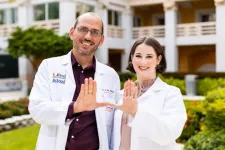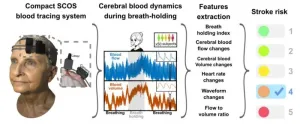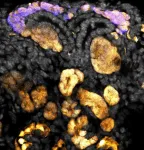(Press-News.org) Microplastic pollution is a significant environmental problem that harms animals and people and affects ecosystems worldwide. These tiny pieces of plastic, smaller than five millimeters, are pushed by wind and water to move around the globe.
Nasrin Alamdari, an assistant professor in the FAMU-FSU College of Engineering’s Department of Civil and Environmental Engineering, is on a mission to learn more about microplastics and how they move.
In research published in Environmental Pollution, she helped examine how shape, size and density affect the speed at which microplastic particles sink, which affects how widely they are dispersed by stormwater.
“Not all microplastics move through water in the same way,” Alamdari said. “We need to know more about environmental degradation of microplastics and how they are transported in urban stormwater. This research helps us predict the paths different particles will take, which gives engineers a better understanding of how to capture this pollution.”
The researchers examined how microplastics move from cities into our water systems when it rains. They used modeling to understand how these tiny plastics are transported in urban areas and how their tendency to sink or float affected their travel path.
The study found that the shape of microplastics — like fibers, sheets, and small bits — plays a big role in how fast they sink, especially as they get larger. Smaller plastics tend to float along with the water, while larger ones are affected by their shape, size, and the water flow conditions.
More than 80% of the plastic introduced into the marine environment comes from inland sources, fueling a big push to find long-term solutions for this growing problem. Hard surfaces in cities make it easy for microplastics to be washed into rivers and lakes, which is bad for organisms and can also affect human health.
“Urban areas, with their impervious surfaces, facilitate the rapid transportation of these microplastics into nearby water bodies, leading to contamination of aquatic ecosystems and potential risks to public health,” Alamdari explained.
Everything from residential, industrial and commercial entities to roads and highways contributes to microplastic pollution released in urban stormwater runoff. Even wind can transport light and tiny microplastics. By studying the material’s density, shape and size, scientists can model how these microplastics travel through the environment, informing strategies to integrate infrastructure into traditional stormwater management practices.
“Permeable pavements, rain gardens and vegetated swales could be strategically deployed to reduce the transport of microplastics by enhancing filtration, trapping these particles before they reach storm drains,” Alamdari said. “The slope of the land and the roughness of surfaces can affect how microplastics move. Knowing this, city planners can design better green spaces and stormwater systems to trap microplastics.”
Co-authors on this study were from the University of Missouri, the Missouri Water Center and Imam Khomeini International University in Iran. Arghavan Beheshtimaal, from the University of Missouri, is the paper’s main author. This research was supported by the National Science Foundation.
For more about the FAMU-FSU College of Engineering, visit eng.famu.fsu.edu.
END
Tracking microplastics: FAMU-FSU College of Engineering researcher helps discover how microplastics move for better storm water management
2024-10-01
ELSE PRESS RELEASES FROM THIS DATE:
The Lancet Psychiatry: Conversion practice linked to greater risk of mental health symptoms, surveys of LGBTQ+ people in the USA suggest
2024-09-30
Analysis of questionnaires completed by 4,426 LGBTQ+ people in the USA suggests undergoing conversion practice targeting gender identity or sexual orientation is linked with symptoms of depression, PTSD and suicidal thoughts or attempts.
Cisgender and transgender participants also had more severe symptoms of depression and PTSD if they had undergone conversion practice.
Cisgender participants subjected to both types of conversion practice had a greater risk of suicidal thoughts and attempts than transgender participants – but mental health symptoms were more severe for transgender people overall, ...
Most accurate ultrasound test could detect 96% of women with ovarian cancer
2024-09-30
An ultrasound test that detected 96% of ovarian cancers in postmenopausal women should replace current standard of care test in the UK according to a new study.
In a paper published in Lancet Oncology today (Monday 30 September), research funded by the National Institute for Health and Care Research (NIHR) and led by Professor Sudha Sundar from the University of Birmingham compared all currently available tests to diagnose ovarian cancer in postmenopausal women head-to-head in a high-quality diagnostic test accuracy study.
Of the six diagnostic tests investigated, ...
Sylvester study: MRI provides early warning system for glioblastoma growth
2024-09-30
MIAMI, FLORIDA (EMBARGOED UNTIL SEPT. 30, 2024, AT 5:40 P.M. EDT) – A new study shows the potential power of imaging paired with radiation to shape treatment for glioblastoma patients in real time.
The study, led by researchers at Sylvester Comprehensive Cancer Center, part of the University of Miami Miller School of Medicine, is the first to quantify tumor changes in glioblastoma patients receiving MRI-guided radiation therapy. This novel technique, also known as MRI-linear accelerator or MRI-linac, pairs ...
Making soybeans smarter
2024-09-30
Ron Mittler is on a quest to create a smarter soybean. For years, mid-Missouri has withstood unpredictable weather patterns, including drought, heat waves and flooding — conditions that are known to hamper agricultural yields and make it difficult for farmers to produce. While we can’t control the weather, Mittler and his team are working to harness soybean crops’ natural ability to adapt to unfavorable weather conditions while also increasing their yields.
Working with $2.4 million from ...
New wearable laser device monitors brain blood flow to gauge stroke risk
2024-09-30
WASHINGTON — Researchers have developed a laser-based device that can be placed on the head to non-invasively monitor changes in brain blood flow and volume. The new device could one day help save lives by offering a direct and simple way to assess stroke risk based on physiological markers rather than indirect markers like lifestyle factors.
Strokes occur when blood flow to the brain is blocked or reduced, causing debilitating brain cell damage. With about 15 million people worldwide affected by strokes each year, it is the second leading cause of death and ...
BU professor receives $29M NIH grant to study dementia risk factors, prevention, and treatment
2024-09-30
FOR IMMEDIATE RELEASE
Monday, September 30, 2024
Contact:
Jillian McKoy, jpmckoy@bu.edu
Michael Saunders, msaunder@bu.edu
##
BU Professor Receives $29M NIH Grant to Study Dementia Risk Factors, Prevention, and Treatment
The Triangulation of Innovative Methods to End Alzheimer’s Disease project will use large, diverse datasets to examine whether interventions targeting alcohol use, depression, vision or hearing impairments, or social isolation can protect people from Alzheimer’s disease and related dementias. This project is a collaboration among Dr. Maria Glymour at Boston University School of Public Health, Dr. Jacqueline ...
Ninth Circuit reverses lower court, reinforces FDA's authority to regulate unproven stem cell products
2024-09-30
In an important step to protect the public from unproven stem cell products, the U.S. Court of Appeals for the Ninth Circuit ruled in favor of the U.S. Food and Drug Administration in U.S. v. California Stem Cell Treatment Center, Inc., reversing the district court. The reversal fortifies FDA’s tiered, risk-based framework for the regulation of cell therapies and is consistent with a similar ruling in the Eleventh Circuit in 2021.
The appellees urged the Ninth Circuit to uphold the lower court’s ...
Wnt happens in kidney development?
2024-09-30
A group of essential signaling molecules known as the Wnt pathway emerged early in the evolution of multicellular life. Scientists have been studying Wnt actions for four decades to comprehend its complex roles in development and disease. In development of the mammalian kidney, USC Stem Cell scientists from Andy McMahon’s lab undertook a pair of complementary studies, published today in the journal Development, that provide new insight into the critical role of Wnt signaling in initiating the development of the mammalian kidney.
“Many stem and progenitor cells require Wnt signaling, ...
Where flood policy helps most — and where it could do more
2024-09-30
Flooding, including the devastation caused recently by Hurricane Helene, is responsible for $5 billion in annual damages in the U.S. That’s more than any other type of weather-related extreme event.
To address the problem, the federal government instituted a program in 1990 that helps reduce flood insurance costs in communities enacting measures to better handle flooding. If, say, a town preserves open space as a buffer against coastal flooding, or develops better stormwater management, area policy owners get discounts on their ...
Combining AI and thermal video offers a new window into weightlifting
2024-09-30
WASHINGTON — Researchers have developed a new method that combines video from thermal cameras with AI-based digital processing to enhance weightlifting training. By providing data-driven insights that enable targeted training and recovery strategies, the approach could help to optimize performance and safety in a variety of sport and exercise contexts.
Thermal, or infrared, images can provide valuable information for sports and health by tracking muscle activation and detecting areas of strain or fatigue. This information can be used to prevent injuries, monitor thermal responses and quantify physical exercise, ultimately helping athletes boost their skills. However, most ...




